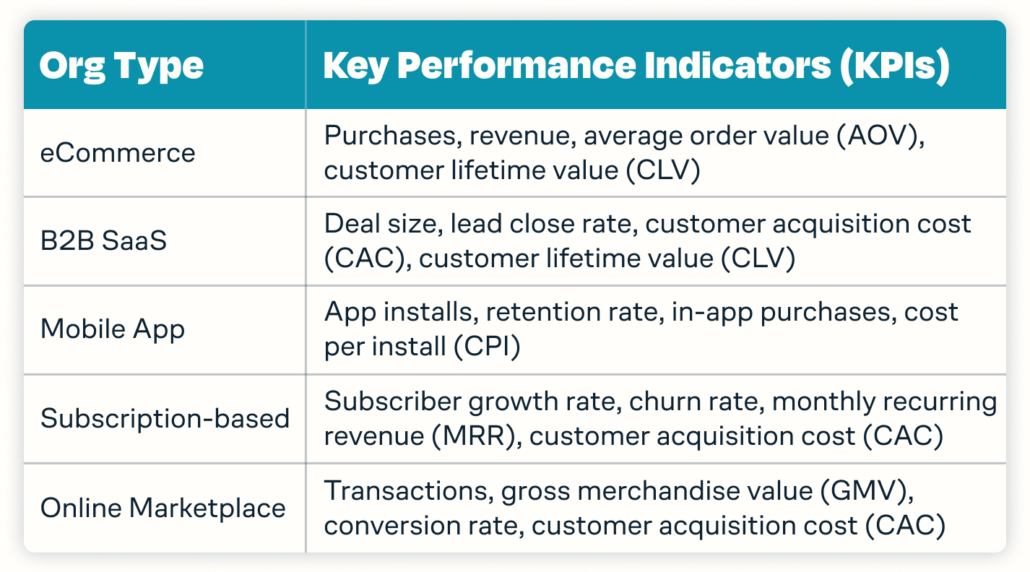Fueling Growth: Performance-Based Marketing for Growth-Driven Organizations
Are you leading a growth-focused organization eager to boost your marketing outcomes? Whether you’re a high-growth startup, a mid-market business, or an enterprise managing multiple business units, marketing that drives real, measurable results is non-negotiable.
That’s why the phrase you need to keep an ear out for—whether either hiring an agency or building out an in-house team—is performance marketing.
Performance-based marketing strategies are driven by tangible business results. The channels and tactics associated with performance marketing strategies are flexible. They span across search engines, social media networks, AI chatbots, websites, and more, but the goal is consistent: Generate direct revenue for the business as a result of marketing efforts.
This article explores how performance marketing applies across company stages—from startups to enterprises—what to consider when adopting a performance mindset, and how to measure success at scale.
Understanding the Basics: Performance-Based Marketing Demystified
Simply put, performance marketing measures all marketing efforts with a dollar and cents contribution to the company’s bottom line. Metrics like revenue, CPA (cost per acquisition) and ROAS (return on ad spend) are taken into account for every decision made within the marketing strategy. While the focus of other marketing varieties might end with higher funnel metrics like impressions or video views, performance marketing follows those interactions all the way to revenue-generating activities.
For early-stage startups, this mindset is essential for survival. But for enterprise organizations, performance marketing helps ensure marketing budgets are accountable, scalable, and optimized across regions, channels, and teams. Performance marketing means adopting a mindset of optimization toward company revenue across the board. This includes content development, performance ad creative, conversion-optimized websites, and more.
Every effort from your marketing team has the potential to generate revenue for your startup, but not everything is optimized for that specific purpose. A video or blog post without supporting data is often wasted effort. That’s why this kind of content isn’t usually part of a performance-based marketing strategy.
Kicking Off a Performance Marketing Strategy
While there’s no such thing as a one-size-fits-all performance marketing plan, there are basic fundamentals to nail before you’re off to the races. We recommend defining your audiences, identifying your unique value props, and refining your messaging strategy. But before diving into your tactic mix, you need to clearly define the goals of your marketing efforts.
Defining these higher-level goals is something that happens very early in our partnerships, often during our first call. During these initial conversations, we ask questions like:
- What are your organization’s revenue goals for this month, quarter, and fiscal year?
- How does your organization currently measure marketing efforts?
- What tactics has your organization tested in the past?
- How does your company currently generate revenue? Are there multiple revenue streams we can promote to users?
After integrating this data with our own research and expertise on growth opportunities and market competition, we develop marketing strategies. These strategies revolve around various channels to acquire new users, spanning from search engines to programmatic display networks.
Channel Mix is Key
To be clear, performance marketing is not only allocating efforts toward what drives “last-click” conversions. We typically recommend a channel mix that covers each part of the acquisition funnel, even if certain channels aren’t driving directly attributable last-click revenue. We have measurement strategies in place to ensure that some of these higher funnel tactics, like organic search acquisition or video marketing, are contributing to larger revenue growth.
Measuring Success: Key Metrics for Performance Evaluation
You can’t call a marketing strategy performance-focused if there’s no strong measurement framework in place. Measurement is the backbone of performance marketing, and it’s how we evaluate the success of our efforts. It’s also the engine that drives all of our decision making and optimizations.
To build an effective measurement framework, you’ll need to start with identifying the main KPIs of your business.
Regardless of your business or industry, identifying main KPIs is the first step to building your measurement framework.
From here, we break down our KPIs by tactic and channel. It’s worth repeating that not all channels merit the same measurement framework. Some high-funnel channels prioritize metrics such as CPM and video watch rate. Lower funnel channels, however, concentrate on actions directly linked to revenue, like purchases and qualified lead submissions.
Using Multi-Touchpoint Attribution
We acknowledge that each partner requires a unique, tailored approach to measurement frameworks. Multi-touch attribution is an invaluable tool for accurate measurement support. It offers options to comprehensively understand the effects of diverse marketing strategies. Leveraging multi-touch attribution enables us to make informed decisions that drive results.
These tools allow leaders to clearly understand which channels contribute to revenue and where to scale or trim budgets.
Adopting a Performance Marketing Mindset
There are countless ways to approach building and executing a performance marketing strategy. Regardless of the size of your organization, adapting a performance-forward mindset is essential to survive and scale.
Performance is at the heart of every marketing strategy that we build for every single one of our partners. We integrate closely with our partners to set, achieve, and exceed growth goals. If you run startup or scaleup that’s interested in how the Tuff team can build a performance marketing strategy for your company, don’t hesitate to reach out!

Hi there! I’m Ethan, a Growth Marketer based in Steamboat Springs, Colorado. I have four years of digital agency experience under my belt creating and executing acquisition strategies for a number of different verticals across multiple channels. When I’m not at my desk, you can find me skiing, mountain biking, or chasing my dog around in the mountains.







